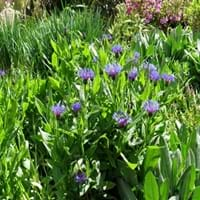Life Span
Biennial and Perennial
Annual and Perennial
Type
Vegetable
Flowering Plants, Shrubs
Origin
Europe, Western Asia
World/Pandemic, North America, Europe, Russia/Siberia, China, Korea
Types
Not Available
Bigleaf hydrangea, Hortensia, Smooth hydrangea, Oakleaf hydrangea, Annabelle
Number of Varieties
Not Available
Habitat
waste ground, wastelands
Forest edges, Hillside, Woods
USDA Hardiness Zone
4-9
2-11
Sunset Zone
A1, A2, A3, H1, H2, 1a, 1b, 2a, 2b, 3a, 3b, 4, 5, 6, 7, 8, 9, 10, 11, 12, 13, 14, 15, 16, 17, 18, 19, 20, 21, 22, 23, 24
Not Available
Habit
Rosette/Stemless
Upright/Erect
Flower Color
Yellow
Blue, Sky Blue, Indigo, Dark Blue
Flower Color Modifier
Bicolor
Bicolor
Fruit Color
Brown, Black
Brown, Sandy Brown
Leaf Color in Spring
Green
Sea Green, Gray Green
Leaf Color in Summer
Green
Sea Green, Gray Green
Leaf Color in Fall
Green
Sea Green, Gray Green
Leaf Color in Winter
Not Available
Light Green
Leaf Shape
Pinnate
Oblovate
Plant Season
Summer
Spring, Summer, Fall
Sunlight
Full Sun
Full Sun, Partial Sun
Growth Rate
Medium
Very Fast
Type of Soil
Loam
Loam, Sand
The pH of Soil
Neutral
Acidic, Neutral, Alkaline
Soil Drainage
Well drained
Well drained
Bloom Time
Summer
Indeterminate
Tolerances
Drought
Drought
Where to Plant?
Ground, Pot
Container, Ground, Pot
How to Plant?
Seedlings
Seedlings
Plant Maintenance
Medium
Medium
Watering Requirements
Average Water Needs, Do Not over Water, Keep the ground moist but not water-logged
Keep ground moist, Requires a lot of watering, Requires regular watering, Requires watering in the growing season
In Summer
Lots of watering
Lots of watering
In Spring
Moderate
Moderate
In Winter
Average Water
Average Water
Soil pH
Neutral
Slightly Acidic
Soil Drainage Capacity
Well drained
Loamy
Sun Exposure
Full Sun
Full Sun
Pruning
Remove damaged leaves, Remove dead branches, Remove dead leaves
Prune to control growth, Remove damaged leaves, Remove dead branches, Remove dead leaves
Fertilizers
All-Purpose Liquid Fertilizer
Compost
Pests and Diseases
Aphids, Armyworm, Cutworms, Downy mildew, Pitch canker, Red blotch
Bacterial leaf spot, Botrytis Blight, Leafminers, Mealybugs, Mushroom root rot
Plant Tolerance
Drought
Drought
Flower Petal Number
Not Available
Single
Fragrant Bark/Stem
Yes
No
Foliage Texture
Fine
Medium
Foliage Sheen
Matte
Matte
Attracts
Butterflies
Butterflies
Allergy
Stomach burn
Chest tightness, Diarrhea, Dizziness, Nausea, Vomiting
Aesthetic Uses
Not Available
Beautification, Bouquets, Landscape Designing, Showy Purposes
Beauty Benefits
Blood purifying, Good for skin
Not Available
Environmental Uses
Air purification
Air purification, Food for insects, Indoor Air Purification, Prevent Soil Erosion, Very little waste
Medicinal Uses
Aphrodisiac
Fever, Kidney problems, Urinary tract problems
Part of Plant Used
Root
Flowers, Root
Other Uses
Food for animals, Used as a nutritious food item
Can be made into a herbal tea, Decoration Purposes, Employed in herbal medicine, Showy Purposes, Used as Ornamental plant, Used for its medicinal properties
Used As Indoor Plant
Yes
Yes
Used As Outdoor Plant
Yes
Yes
Garden Design
Edible, Herb, Vegetable
Container, Herb
Botanical Name
PASTINACA sativa
CENTAUREA cyanus
Common Name
Parsnip
Batchelor's Buttons, Cornflower
In Hindi
चुकंदर
Hydrangea
In German
Pastinake
Hortensie
In French
Panais
Hortensia
In Spanish
Chirivía
Hortensia
In Greek
Είδος δαυκίου
υδραγεία
In Portuguese
cherivia
Hortênsia
In Polish
Pasternak
Hortensja
In Latin
parsnip
Hibiscus
Phylum
Magnoliophyta
Anthophyta
Class
Magnoliopsida
Magnoliopsida
Family
Apiaceae
Asteraceae
Clade
Angiosperms, Asterids, Eudicots
Angiosperms, Asterids, Eudicots
Tribe
Not Available
Cynareae
Subfamily
Not Available
Carduoideae
Number of Species
Not Available
Not Available
Season and Care of Parsnip and Cornflower
Season and care of Parsnip and Cornflower is important to know. While considering everything about Parsnip and Cornflower Care, growing season is an essential factor. Parsnip season is Summer and Cornflower season is Summer. The type of soil for Parsnip is Loam and for Cornflower is Loam, Sand while the PH of soil for Parsnip is Neutral and for Cornflower is Acidic, Neutral, Alkaline.
Parsnip and Cornflower Physical Information
Parsnip and Cornflower physical information is very important for comparison. Parsnip height is 15.20 cm and width 7.60 cm whereas Cornflower height is 30.00 cm and width 30.00 cm. The color specification of Parsnip and Cornflower are as follows:
Parsnip flower color: Yellow
Parsnip leaf color: Green
Cornflower flower color: Blue, Sky Blue, Indigo and Dark Blue
- Cornflower leaf color: Sea Green and Gray Green
Care of Parsnip and Cornflower
Care of Parsnip and Cornflower include pruning, fertilizers, watering etc. Parsnip pruning is done Remove damaged leaves, Remove dead branches and Remove dead leaves and Cornflower pruning is done Prune to control growth, Remove damaged leaves, Remove dead branches and Remove dead leaves. In summer Parsnip needs Lots of watering and in winter, it needs Average Water. Whereas, in summer Cornflower needs Lots of watering and in winter, it needs Average Water.





